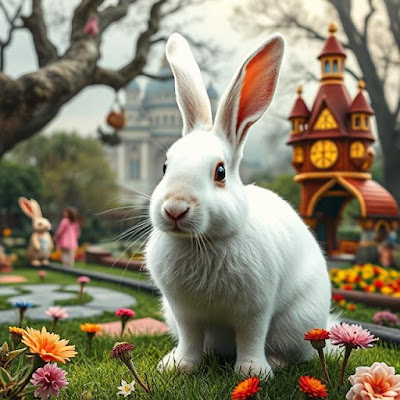Few songs capture the spirit of the psychedelic 1960s as completely as Jefferson Airplane’s “White Rabbit.” Released on their seminal 1967 album Surrealistic Pillow, this two-and-a-half-minute masterpiece is a hypnotic, surreal march into the heart of countercultural consciousness. Written by lead singer Grace Slick, “White Rabbit” is equal parts Lewis Carroll fantasy, social commentary, and musical rebellion.
The song draws heavily from Alice’s Adventures in Wonderland and Through the Looking-Glass, using characters like the White Rabbit, the Dormouse, and the Red Queen as allegorical stand-ins for expanded consciousness and altered perception. But beneath the whimsical references lies a sharper message: Slick subtly critiques the double standards of a society that feeds its children sanitized fairy tales but condemns them for seeking their own version of wonder through psychedelics. “Feed your head”, she urges in the song’s climactic mantra - part warning, part liberation.
Musically, “White Rabbit” is unlike anything else on Surrealistic Pillow. With its Spanish-influenced bolero rhythm, minor-key arrangement, and Slick’s commanding vocal crescendo, the song builds with relentless intensity. Her voice - clear, powerful, and unwavering - delivers the lyrics with theatrical force, like a prophet at the edge of a dream. Jorma Kaukonen’s guitar and Jack Casady’s bass add a dark undercurrent that keeps the fantastical imagery grounded in something brooding and serious.
The track’s brevity only adds to its impact. There’s no excess here, just a slow build to a peak that ends as abruptly as it begins, leaving a lingering echo of mystery. This song doesn’t just describe a trip - it is one, compressed into 150 seconds of mesmerizing sound.
“White Rabbit” is more than a psychedelic anthem - it’s a cultural time capsule and a bold piece of musical art. Grace Slick’s commanding performance and the band’s moody, exotic arrangement make it a defining track of the era and a standout on Surrealistic Pillow. So many decades later, it still leads listeners down the rabbit hole - and it still demands that we think while we dream.
The song draws heavily from Alice’s Adventures in Wonderland and Through the Looking-Glass, using characters like the White Rabbit, the Dormouse, and the Red Queen as allegorical stand-ins for expanded consciousness and altered perception. But beneath the whimsical references lies a sharper message: Slick subtly critiques the double standards of a society that feeds its children sanitized fairy tales but condemns them for seeking their own version of wonder through psychedelics. “Feed your head”, she urges in the song’s climactic mantra - part warning, part liberation.
Musically, “White Rabbit” is unlike anything else on Surrealistic Pillow. With its Spanish-influenced bolero rhythm, minor-key arrangement, and Slick’s commanding vocal crescendo, the song builds with relentless intensity. Her voice - clear, powerful, and unwavering - delivers the lyrics with theatrical force, like a prophet at the edge of a dream. Jorma Kaukonen’s guitar and Jack Casady’s bass add a dark undercurrent that keeps the fantastical imagery grounded in something brooding and serious.
The track’s brevity only adds to its impact. There’s no excess here, just a slow build to a peak that ends as abruptly as it begins, leaving a lingering echo of mystery. This song doesn’t just describe a trip - it is one, compressed into 150 seconds of mesmerizing sound.
“White Rabbit” is more than a psychedelic anthem - it’s a cultural time capsule and a bold piece of musical art. Grace Slick’s commanding performance and the band’s moody, exotic arrangement make it a defining track of the era and a standout on Surrealistic Pillow. So many decades later, it still leads listeners down the rabbit hole - and it still demands that we think while we dream.
